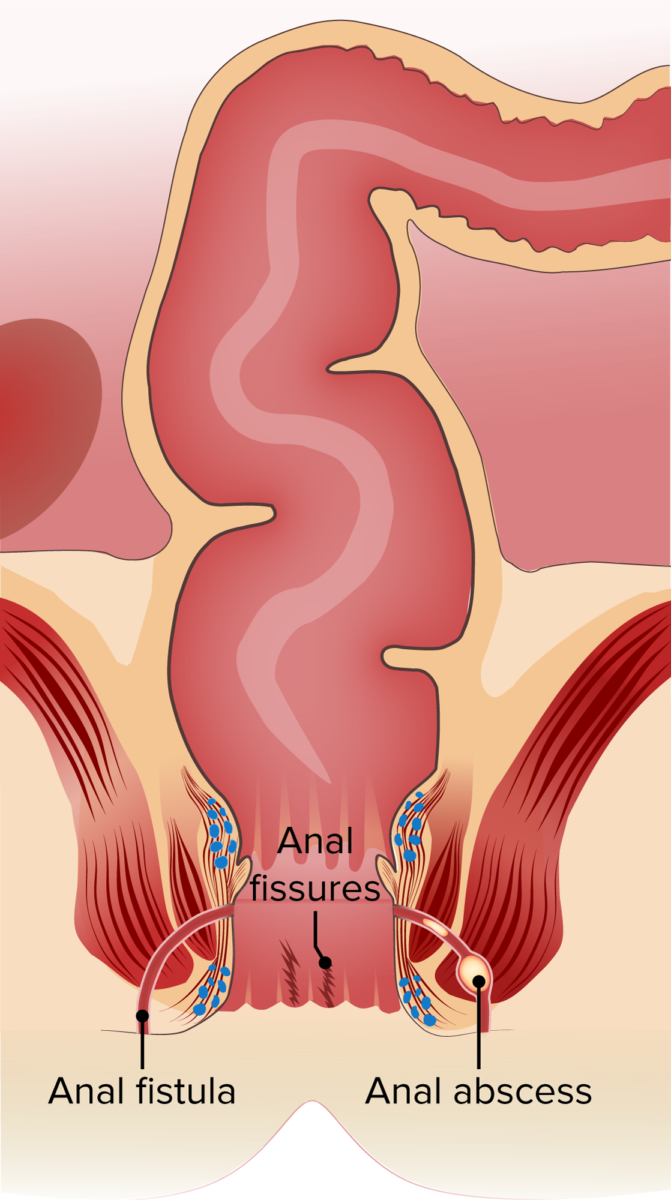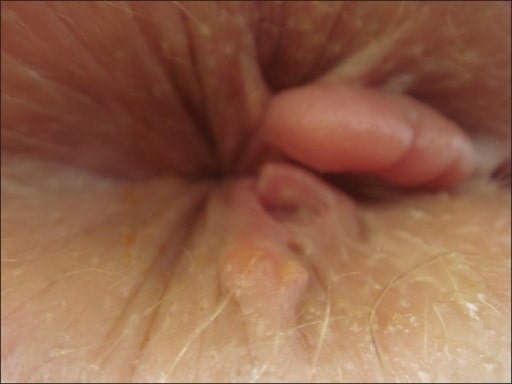An anal fissure is a painful superficial tear of the epithelial lining (anoderm) of the anal canal. Anal fissures most often occur secondary to local trauma or irritation from constipation, diarrhea, anal intercourse, or perineal lacerations during childbirth. Treatment is generally conservative with stool softeners, bulking agents, sitz baths, and/or topical vasodilators.
Last updated: Sep 10, 2025

Anal disorders: fistula, fissures and abscess
Image by Lecturio.
Chronic anal fissure and marisca (large kind of haemorrhoid)
Image: “Chronic anal fissure and marisca” by Department of Dermatology and Allergology, Hospital Dresden-Friedrichstadt, Academic Teaching Hospital of the University of Dresden, Friedrichstrasse 41, Dresden, Germany. License: CC BY 2.0Mnemonic:
The D’s of anal fissures Anal fissures A painful linear tear at the margin of the anus. It appears as a crack or slit in the mucous membrane of the anus and is very painful and difficult to heal. Constipation:
The following information is based on the practice guidelines from the American Society of Colon and Rectal Surgeons and the American College of Gastroenterology. Management may be area-dependent; UK guidance on therapies, duration of treatment, and referral indications may vary slightly by clinical commission group.
Non-operative treatment:
Goals:
Treatment may include:
Diagnosis Codes:
These codes are used to diagnose an anal
fissure
Fissure
A crack or split that extends into the dermis
Generalized and Localized Rashes, a small tear in the lining of the anus. The codes differentiate between an acute and a
chronic fissure
Chronic fissure
Anal Fissure.
| Coding System | Code | Description |
|---|---|---|
| ICD-10-CM | K60.0 | Acute anal fissure Fissure A crack or split that extends into the dermis Generalized and Localized Rashes |
| ICD-10-CM | K60.1 | Chronic anal fissure Fissure A crack or split that extends into the dermis Generalized and Localized Rashes |
Procedures/Interventions:
This code is for a lateral internal
sphincterotomy
Sphincterotomy
Surgical incision of a sphincter.
Anal Fissure, a surgical procedure for chronic
anal fissures
Anal fissures
A painful linear tear at the margin of the anus. It appears as a crack or slit in the mucous membrane of the anus and is very painful and difficult to heal.
Constipation that do not respond to medical therapy. It involves cutting the
internal anal sphincter
Internal anal sphincter
Rectum and Anal Canal: Anatomy muscle to reduce spasm and promote healing.
| Coding System | Code | Description |
|---|---|---|
| CPT | 46200 | Fissurectomy, with or without sphincterotomy Sphincterotomy Surgical incision of a sphincter. Anal Fissure |
Medications:
These codes are for topical medications used as first-line treatment for
anal fissures
Anal fissures
A painful linear tear at the margin of the anus. It appears as a crack or slit in the mucous membrane of the anus and is very painful and difficult to heal.
Constipation.
Nitroglycerin
Nitroglycerin
A volatile vasodilator which relieves angina pectoris by stimulating guanylate cyclase and lowering cytosolic calcium. It is also sometimes used for tocolysis and explosives.
Nitrates and
diltiazem
Diltiazem
A benzothiazepine derivative with vasodilating action due to its antagonism of the actions of calcium ion on membrane functions.
Class 4 Antiarrhythmic Drugs (Calcium Channel Blockers) ointments work by relaxing the anal sphincter muscle.
| Coding System | Code | Description |
|---|---|---|
| RxNorm | 7494 | Nitroglycerin Nitroglycerin A volatile vasodilator which relieves angina pectoris by stimulating guanylate cyclase and lowering cytosolic calcium. It is also sometimes used for tocolysis and explosives. Nitrates (ingredient) |
| RxNorm | 3443 | Diltiazem Diltiazem A benzothiazepine derivative with vasodilating action due to its antagonism of the actions of calcium ion on membrane functions. Class 4 Antiarrhythmic Drugs (Calcium Channel Blockers) (ingredient) |